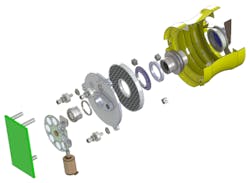| An exploded view shows a CubeSat-class 50 mm imaging instrument that technologist Jason Budinoff is manufacturing with 3D-printed parts. (Image credit: NASA Goddard/Jason Budinoff) |
By the end of September 2014, Jason Budinoff, an aerospace engineer at NASA's Goddard Space Flight Center (Greenbelt, MD), is expected to complete the first imaging telescopes ever assembled almost exclusively from 3D-manufactured components. The devices' optics and electronics will be fabricated using conventional methods.
"As far as I know, we are the first to attempt to build an entire instrument with 3D printing," says Budinoff. He is building a fully functional 50 mm camera whose outer tube, baffles, and optical mounts are all printed as a single structure. The instrument is appropriately sized for a CubeSat (a small satellite made of individual units each about 100 mm on a side). When equipped with mirrors and glass lenses, the instrument will undergo vibration and thermal-vacuum testing next year.
Budinoff also is assembling a 350 mm dual-channel telescope whose size is more representative of a typical space telescope.
'Pathfinder' project
Budinoff is developing both to show that telescope and instrument structures can benefit from advances in laser-based additive manufacturing. The goal is not to fly them, or at least not yet. "This is a pathfinder," says Budinoff. "When we build telescopes for science instruments, it usually involves hundreds of pieces. These components are complex and very expensive to build. But with 3-D printing, we can reduce the overall number of parts and make them with nearly arbitrary geometries."
The 50 mm instrument design involves the fabrication of four different pieces made from powdered aluminum and titanium. A comparable, traditionally manufactured camera would require between five and 10 times the number of parts. In addition, the instrument's stray-light baffling is angled in a configuration that instrument builders cannot create with traditional manufacturing approaches in a single piece.
3D-printed optics next?
Budinoff also wants to demonstrate that he can use powdered aluminum to produce 3D-manufactured telescope mirrors -- a challenge given how porous aluminum is, which makes it difficult to polish the surfaces. Under his plan, a 3D-manufacturing vendor will fabricate an unpolished mirror blank appropriate for his 50 mm instrument. He then will place the optic inside a pressure chamber filled with inert gas. As the gas pressure increases to 15,000 psi, the heated chamber will squeeze the mirror to reduce the surface porosity (hot isostatic pressing).
Infrared-sensing instruments operating at cryogenic temperatures could benefit. Often, these instruments are made of different materials. However, if all the instrument's components, including the mirrors, were made of aluminum, then many of the separate parts could be 3D printed as single structures, reducing the parts count and material mismatch.
Next year, Budinoff also plans to experiment with printing instrument components made of Invar alloy, which is being prepared for 3D printing by Goddard technologist Tim Stephenson.
